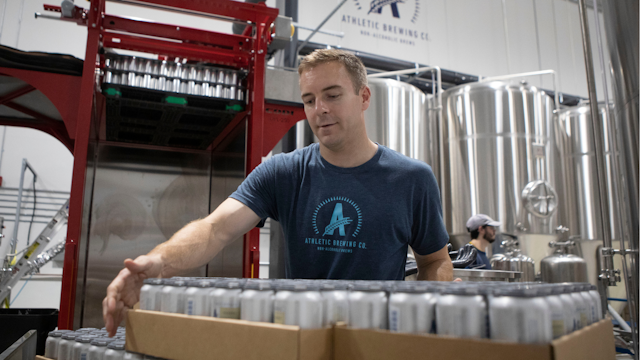Athletic Brewing Company races ahead in zero-alcohol craft beer category
As part of The Drum’s latest Deep Dive, Marketing Secrets of Fast-Growth Brands, we catch up with Bill Shufelt, chief executive and co-founder of Athletic Brewing, who shares his vision for the non-alcoholic beer brand that’s adding capacity, marketing dollars and legions of fans by the day.
“I had two already today!” Normally, an interviewee admitting they’re a couple of beers deep when you catch up with them early-afternoon could be cause for concern. But for Athletic Brewing Company chief executive and co-founder Bill Shufelt, it’s just proof positive of the opportunities that lie ahead for the non-alcoholic beer segment.
“If you put a six pack in your fridge, you’d be surprised how often you go for it, and of all the different beer occasions there can be,” he tells The Drum. “The beer world, in general, was missing 80% of potential drinking occasions. It’s a great reward in the afternoon or at the end of the workday, but it doesn’t derail you at all.”
It wasn’t that long ago that the idea of a non-alcoholic beer in the US comprised of an O’Douls with the label tactfully turned inward so no one knew what you were drinking. Overseas, meanwhile, some larger brands such as Heineken were successfully replicating their core products with no alcohol, and today that trend is spilling over to US shores where Heineken 0.0 has become the category leader. Overall, the non-alcoholic beer trend is quickly picking up steam with AB InBev pushing hard behind Bud Zero and a bevy of other craft brewers prepping their own products.
But Athletic Brewing and its “Beer without compromise” decree is the far and away leader in the craft segment with its bold packaging, flavor and vision. And it is planning to quadruple production this year and begin to market its product at scale.
Athletic Brewing was “in the right place at the right time” says David Steinman, the executive editor of Beer Marketer’s Insights. “You can credit it with creating the non-alcoholic craft beer trend.”
No more ordering drinks off of the kids’ menu
It all started about five years when it occurred to Shufelt that “it was like ordering off of the kids’ menu if you weren’t drinking alcohol”. He says: “Having a beverage option to pair with the meal is a huge part of the experience.”
At the time, Shufelt was getting serious about his workouts and his relationship, with marriage on the horizon. He also quickly became less serious about his finance gig. “I just thought there are a lot of people shut out from the beer world. Almost 50% of adults don’t drink. And then another 15 million Americans suffer from alcohol use disorder. I began to see the real potential to have a positive impact on tens of millions of Americans.”
He found a partner with a similar vision in brewmaster John Walker. Together, they saddled up in an empty warehouse and spent a year working on the product. “Once it started tasting good, we took it to Whole Foods. They understood it immediately and it was off to the races ever since.”
It has been a bit of perfect storm of opportunity ever since. Between the rise of dry January and the sober curious movement there appears to be a zeitgeist happening. At the very least, the stigma that was attached to drinking a non-alcoholic beer is falling away as new options abound.
“There’s the sober curious movement and the fact that younger people don’t like to be smashed all the time,” says Gerry Khermouch, editor of Beverage Marketer’s Insights. “They are looking for a sociable beverage to avoid that. It’s a broader trend that’s carried over to whiskies and gins… The revelation [for Athletic Brewing] was the sheer range of consumption occasions it serves and breadth of consumer demographics receptive to it.”

Big competition equals big opportunity
To date, Heineken 0.0 and Athletic Brewing account for the majority on non-alcoholic beer sales in the US. Plus, says Khermouch, “there’s a whole flotilla of products arriving in the market that has totally changed the conversation.”
Athletic Brewing sold more than 100,000 barrels last year, putting it within the top 25 brewers nationally. Run Wild IPA is its most highly awarded and best-selling beer. Free Wave Hazy IPA and Upside Dawn Golden Ale are also top sellers.
It purchased Ballast Point’s production facility in San Diego and is in the final stages of building a new brewery in Connecticut. This will allow the company to produce 200,000 barrels, on each coast, by mid-year. And the Connecticut facility can be expanded. “It shows you just how big it is thinking,” says Steinman.
It’s all about meeting demand, says Shufelt. “Our ambition is to get our beer in the hands of everyone who wants one. We haven’t been able to deliver on that yet.”
Three different funding rounds that have led to “ungodly amounts of capital” will certainly help, says Khermouch. “It is going for broke, building out significant brewing capabilities on both coasts. It doesn’t seem daunted by the Bud and Heineken alternatives... Although it’s a double-edged sword with these big companies, because they are spending massive amounts of money to build category awareness, but at the same time they’re trying to put you out of business.”
Indeed, Heineken 0.0 is the category leader, growing 30% to 240,000 barrels in 2021, per Beer Marketer’s Insights. It began marketing heavily in the US in 2019. Bud Zero launched last July. Guinness 0.0 is expected to hit the US this summer.
Athletic Brewing is gearing up by prepping its marketing plans as well as new product innovations. It hired its first chief marketer, Andrew Katz, in October. Katz is an ad industry veteran who spent more than 10 years at PepsiCo marketing everything from sparkling water to SoBe to Mountain Dew and brand Pepsi. He was also vice-president of marketing at the Heineken Company, working on Dos Equis. Decidedly on-brand, Katz is a cycling instructor and founder of Instructrr Live, a virtual studio platform for fitness creators.
The brand will “focus on all drinkers” but with a sweet spot target audience of under-44 outdoors types. It currently has a 50-50 male-female split.
It will stick with the athletic appeal that is true to the brand’s DNA, says Shufelt. “It’s super authentic to who we are.”
So much so, the brand’s initial marketing comprised entirely of Shufelt handing out cans of beer at races. “My goal was to put the 1,000 beers in people’s hands every weekend, tell them about the brand and blow their minds. It wasn’t like I had to Google where our target demo would be. It started with me doing 75 events that first summer and that was built out to sampling at 1,000 races last year.”
Athletic Brewing will also continue to lean into its charitable efforts. Its ’Two for the Trails’ program gives 2% of all sales to the building and cleanup of trails and parks. So far, it has donated $1.4m dollars to communities and environmental causes. “We are making a big impact everywhere we are selling beer,” says Shufelt.
And of course, as is always the case in the beverage category, there will be innovation. It is currently piloting its Daypack sparkling water infused with hops that comes in four flavors: black cherry, blood orange, lemon lime and mango. Its first “emerging brand” is “doing incredibly well,” says Shufelt. “There’s a lot of white space during the day because people are almost lumping sugary sodas with cigarettes these days… We’re going to continue to see how the pilot goes and then consider taking it to a bigger scale.”
Athletic Brewing also has a new beer coming out next month that is still under wraps, as well as a handful of other products in the pipeline. Overall, Shufelt is bullish on his brand and the category as a whole. “Non-alcoholic beers could be the biggest growth driver of beer for over a decade.”
For more Marketing Secrets of Fast-Growth Brands, check out The Drum’s latest Deep Dive. And you can sign up for The Drum’s daily US newsletter here.

